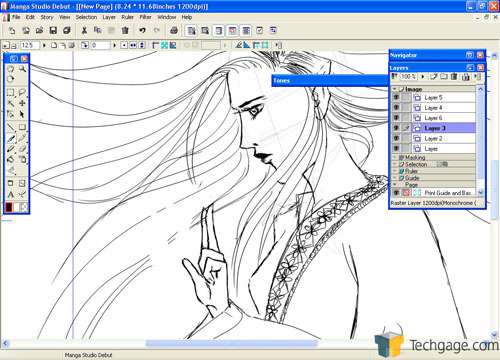- Qualcomm Launches Snapdragon 4 Gen 2 Mobile Platform
- AMD Launches Ryzen PRO 7000 Series Mobile & Desktop Platform
- Intel Launches Sleek Single-Slot Arc Pro A60 Workstation Graphics Card
- NVIDIA Announces Latest Ada Lovelace Additions: GeForce RTX 4060 Ti & RTX 4060
- Maxon Redshift With AMD Radeon GPU Rendering Support Now Available
Manga Studio Debut 3.0

Manga Studio is an extensive art program developed for aspiring manga artists, and has been featured by the popular J-pop magazine Tokyopop. It has an extensive selection of tools available for the manga artist to use at their disposal, which is impressive to say the least. Having all the tools you’ll need to create and publish manga from your desktop? Sounds too good to be true!
Page 1 – Introduction
There are currently two versions of Manga Studio available, Manga Studio EX and Manga Studio Debut. In this review we’ll be looking at Manga Studio Debut 3.0. Although it doesn’t have all the tools that EX has, I’m still excited to be working with it. I will go over some of the features that Manga Studio has and show some examples of what it is capable of in my own hands.

- System Requirements
- Microsoft Windows 98, Millennium Edition, 2000 Professional, XP
- 500MHz or faster (1.0GHz recommended)
- 256MB system RAM (512MB recommended)
- 1.1GB free hard disk space (1.7GB recommended)
- XGA (1024 x 768) 16 bit color display
- Wacom tablet FAVO, Graphire, Inuos, Cintiq, PL series, etc.
- TWAIN 32 flatbed scanner
- CD-ROM drive
- Mac OS X 10.2 (10.2.8) : 10.3 (10.3.9) : 10.4 (10.4.1 or above)
- PowerPC G3 (G3 or later recommended)
- 500MHz or faster (1.0GHz recommended)
- 512MB system RAM (1GB recommended)
- 1.6GB free hard disk space (2.1GB recommended)
- XGA (1024 x 768) 16 bit color display
- Wacom tablet FAVO, Graphire, Inuos, Cintiq, PL series, etc.
- TWAIN 32 flatbed scanner
- CD-ROM drive
- Windows
- Mac
My copy of Manga Studio was downloaded from Content Paradise, and that download didn’t take very long at all on a 3 meg cable connection. You can burn your copy to disk and your issued a virtual key. I recommend writing your key down on your disk, as well as somewhere else safe that you’ll remember. If you purchase Manga Studio I’m sure there is an option to get a mailed CD package. This method was quick and convenient for me and I was able to dive right into it instead of having to wait for a CD to arrive in the mail. Installing was fast and easy, very straight forward and no hassle. I’m sure that most people who’ve used a PC know how to install a program, this is no different.
Many aspiring artists start with the programs available to them, and at the time you’d get the basics like Illustrator, Photoshop. I’m an avid Photoshop junkie and recommend it for all sorts of photo editing and manipulation. Manga Studio is not Photoshop… but Photoshop isn’t Manga Studio. That’s where this gets interesting. Typically an artist will begin their manga on PS or Illustrator, where the tools are more designed for design and manipulation, whereas Manga Studio is all about the comics, with tools designed for comic works.
Manga Studio has true inking capabilities, unlike Photoshop who’s primary design is for painting and digital editing, Manga Studio’s pens are like true inking pens, with many different tip types to chose from, as well as being able to adjust the pens tip size and pressure. Now some people work with a mouse, but I have a tablet and absolutely love the feel of the pens in this program.
Immediately I was impressed with how the ‘ink’ flowed smoothly and the ease of doing ink work over pencil outlines. It was so different that what I’ve been use to. Lines were indeed crisp and clean, and far easier adjusted than PS. If you work with a mouse you miss out on the adjusted pressure you can apply to the pen with a tablet, for its just as if you were working with a real ink tip. The only thing I notice is that at 100% zoom the lines look jagged and things look messy, which leads me to believe that the zoom in this is not exactly correct, or it just isn’t setup like PS and I’m crazy and can’t figure it out. So I typically kept the zoom at a low setting.
Starting a comic is easy, with page presets available for you and auto markers to show bleed and cut off lines. You can create a story and add new pages to it as you go, which is great for organization of your files. All of your works are saved in their own folders with a story set you create. Creating a story saves all page files opened in that story to that directory, so you don’t have to hunt around for where you saved your page files. There are also a bunch of templates you can use for your page setup.
|
|
Support our efforts! With ad revenue at an all-time low for written websites, we're relying more than ever on reader support to help us continue putting so much effort into this type of content. You can support us by becoming a Patron, or by using our Amazon shopping affiliate links listed through our articles. Thanks for your support!









